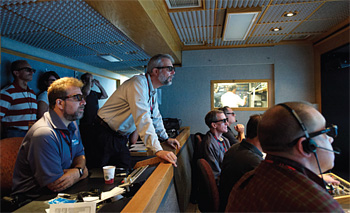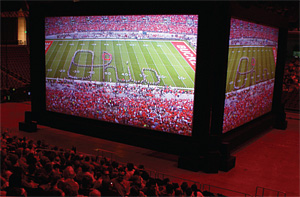NEP Pioneers 3DTV Production
TORONTO
Need proof that 3D television is moving beyond the novelty stage? Then look no further than NEP Broadcasting's Supershooter 3D, which this Pittsburgh provider bills as "the very first Mobile Television Truck designed specifically for producing live 3D television events."

ESPN producers monitor the 3D action during NEP SS3D's first deployment last month. Whether Supershooter 3D (SS3D) truly is the first remains to be seen; some other company may yet surface with a similar claim. But what matters is that NEP has created an end-to-end 3D HDTV production system that broadcasters can use to learn about this new medium. "Supershooter HD puts an end to the ad hoc 3D deployments that we've seen to date," says Joe Signorino, NEP Broadcasting's senior project manager. "This is a truck built entirely for 3D production, rather than a 2D unit with extra 3D equipment integrated into it."
SS3D was put through its inaugural paces last month during the USC and Ohio State football game on Sept. 12. The 3D footage, which was shot using PACE Production's 3D technology, was transmitted live from the field in Columbus, Ohio to three 40-foot screens at USC's Galen Center. It was projected in 3D for fans there, using Sony SXRD 4K video projectors.
"We were very pleased with the results," said Kevin Stolworthy, senior vice president of technology for ESPN. "There's definitely a 'wow factor' with 3D."
At press time, NEP's 3D production trailer was sitting in the shop, awaiting its next assignment. "We've had a lot of interest since the USC-Ohio game," says Signorino. "Still, broadcasters are hesitant about trying 3D, because they are so comfortable operating in a 2D world."
SIDE BY SIDE
The PACE Fusion 3D system is based on the notion that, since humans use two eyes to see in 3D, a 3D HDTV camera system must do the same. In this instance, this means mounting two Sony HDC-1500 HDTV cameras on a PACE stereoscopic rig. In plain English, this rig simply puts the two cameras side-by-side on individually adjustable, remotely-controlled bases.
Back inside the mobile production truck, the operator "tunes" the cameras' positions such that their views "converge," akin to how someone using binoculars adjusts the position of the two lense barrels until they see a 3D image. The converged view—which is actually two separate HD streams from cameras to switcher, until they are overlaid into a single signal that is fed to a monitor—can then be seen as a 3D image by anyone wearing the appropriate 3D glasses.
Worth noting: The camera operator does not wear 3D glasses. Instead, he/she uses the viewscreen/viewfinder on one of the cameras—the one on the left of the rig—to track the action. So what master control is seeing in 3D, the camera operator sees in 2D.
Supershooter 3D is wired to support eight 3D camera sets (two 2D cameras per set). The signals are fed from the cameras in 1080i or 720p format, although the system has enough capacity to carry 1080p signals too. "We have a range of HD cameras in the truck, from the Sony 1500s to smaller Panasonics for handheld use, and even smaller 'cube' cameras for use with jibs or robotics," Signorino said. "In general, we are using cameras that are ENG-sized or smaller." Typically, one of the cameras in the pair is slaved to the other, to ensure that iris and focusing is consistent between the two.
The video is sent as separate 2D feeds to a Sony MVS-8000A video switcher. "We run the MVS-8000a in dual multi-program mode," Signorino said. "We use an SSL Aysis Air PLUS! digital audio console for sound, and record to two 6-channel EVS XT-2 servers and 10 video tape machines." 3D imaging is managed using a PACE "convergence box" and the outputs are ported to flat panel monitors.
3D OPTIONS
In the past, 3D has been used to create an in-your-face "wow factor" in films and TV programs. However, this extreme approach misses the real potential of 3DTV, which is to create a viewing experience that is as authentic as actually being in the stadium personally. It is this form of non-sensational 3D that most interests Signorino.
"I appreciate the kind of 3D that is so realistic that you don't even notice it until you look at a 2D monitor and see the difference," he said.
Stolworthy shares this view. Having sat through some 3D movies with his children, Stolworthy prefers 3D that is "more subtle" rather than the eye-popping variety that "hits you in the head." He expects ESPN to keep experimenting with this new medium—not just for football but also "basketball, golf and other sports.

At the Galen Center on the USC campus, images from the USC-Ohio game were projected onto three screens using six Sony SXRD 4K projectors. Signorino notes that SS3D supports both kinds of 3D shooting, and everything in between. "It is all in camera placement, shot composition and how you set up the convergence point between the two cameras—we call them the 'left eye' and right eye,'" he said. "You can make people float out in the middle of the room, or you can add depth to the picture without putting 3D in the viewer's lap. It's all up to you."
Deciding where the balance is, in HDTV broadcast terms, is what makes the SS3D such an interesting R&D platform. It allows producers to get hands-on experience with 3D, to take it beyond the novelty stage and into something more commercially viable.
AT THE BLEEDING EDGE
In the history of television, there have been some seminal events. Among these are NBC's black-and-white TV broadcasts at the 1939 World's Fair in New York, the launch of U.S. color TV in the late 1950s, and most recently, the transition from analog to digital TV broadcasting earlier this year.
For broadcasters, 3DTV may well be the "Next Big Thing;" not just yet perhaps, but sometime in the future. This is why NEP's SS3D has the potential to make history, because it could be the platform that proves the viability of 3DTV as a broadcast medium. In particular, broadcasters may want to venture into 3DTV to make themselves stand out in the ever-fragmenting TV universe; assuming that ways can be found to broadcast these signals.
As for manufacturer support? Once HDTV has become common in world households, companies such as Sony and Panasonic will be seeking new hooks to keep receiver sales going. 3DTV, should it prove itself in the field, could be a natural.
Signorino is aware of the possibilities attached to this new medium. That's why he is so excited to be linked to SS3D. "It's fun to be at the leading edge of technology," he says. "It's fun to be working with something like SS3D, which may prove to have such an impact on TV's future."
Get the TV Tech Newsletter
The professional video industry's #1 source for news, trends and product and tech information. Sign up below.
James Careless is an award-winning journalist who has written for TV Technology since the 1990s. He has covered HDTV from the days of the six competing HDTV formats that led to the 1993 Grand Alliance, and onwards through ATSC 3.0 and OTT. He also writes for Radio World, along with other publications in aerospace, defense, public safety, streaming media, plus the amusement park industry for something different.

